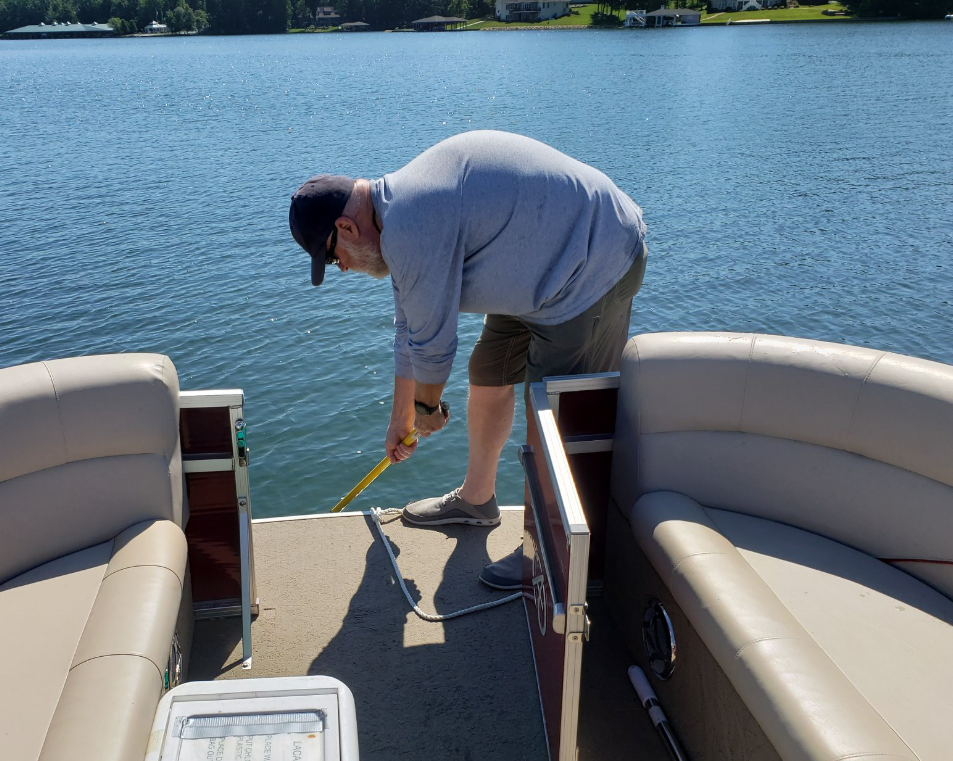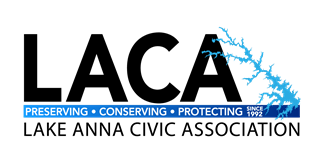By Harry Looney - June 2020
The COVID-19 response and restrictions placed on gatherings resulted in the cancellation of our regular April water monitoring session. Our next scheduled date for sampling has been set for June 23rd when we will be monitoring both lake and stream stations. We selected the 23rd to ensure that we would be monitoring after the start of Virginia's Phase Two COVID-19 restrictions. To reduce risk we developed a detailed set of guidelines for safety and preparedness to ensure everything we do is in accordance with the Governor's Phase 2 restrictions. Our training and Quality Assurance session on June 22nd will be conducted outdoors with a minimum number of people and we are limiting the number of people that go out on the boats on the 23rd to do the monitoring. We are pleased that the Virginia Department of Environmental Quality (DEQ) will be able to resume monitoring activities using watercraft so they will be joining us on the lake on the 23rd. DEQ has been able to conduct stream monitoring since early May but they had not been authorized to conduct boat monitoring during Phase 1 of the COVID-19 restrictions. We will post results of the June monitoring activities on the LACA website as soon as the data are available.
While we have not yet been able to go out and sample in large groups due to the COVID-19 restrictions, we were able to initiate our new algae and toxin monitoring project in May. This project specifically focuses on collecting data on the levels of cyanobacteria found in the lake on both the public and private sides. Cyanobacteria, sometimes called blue-green algae, are naturally found in bodies of freshwater and they can produce and release toxins that are harmful to human health in high levels of concentration. Water chemistry, temperature and other factors can allow these cyanobacteria to rapidly reproduce and grow. When this happens a Harmful Algae Bloom (HAB) can occur and the possibility of high toxin levels is significantly increased. DEQ regularly tests for algae and toxin levels and advisories are issued by the Virginia Department of Health (VDH) when algal cell counts and toxin levels exceed certain levels. LACA added algae and toxin analysis to our Water Quality Monitoring Program in 2020 and we purchased two instruments that allow us to quickly analyze water samples for chlorophyll and phycocyanin, two pigments found in plants and cyanobacteria. Chlorophyll is a pigment found in all plants and cyanobacteria that use photosynthesis to produce sugars for food. Phycocyanin is a pigment found only in cyanobacteria.
private sides. Cyanobacteria, sometimes called blue-green algae, are naturally found in bodies of freshwater and they can produce and release toxins that are harmful to human health in high levels of concentration. Water chemistry, temperature and other factors can allow these cyanobacteria to rapidly reproduce and grow. When this happens a Harmful Algae Bloom (HAB) can occur and the possibility of high toxin levels is significantly increased. DEQ regularly tests for algae and toxin levels and advisories are issued by the Virginia Department of Health (VDH) when algal cell counts and toxin levels exceed certain levels. LACA added algae and toxin analysis to our Water Quality Monitoring Program in 2020 and we purchased two instruments that allow us to quickly analyze water samples for chlorophyll and phycocyanin, two pigments found in plants and cyanobacteria. Chlorophyll is a pigment found in all plants and cyanobacteria that use photosynthesis to produce sugars for food. Phycocyanin is a pigment found only in cyanobacteria.  One of our instruments, the CyanoFluor device made by Turner Designs, measures the levels of chlorophyll and phycocyanin in the samples. This data gives us an indication of cyanobacteria levels in the water. The second instrument, the MQ 2.0 made by MBio Diagnostics, allows us to analyze water samples to determine the levels of two toxins produced by cyanobacteria. We have been out on the lake in May and June taking samples and our analysis indicates low to moderate levels of cyanobacteria are present in the lake at this time, as we would expect for the early part of the recreation season. We will continue to monitor our sampling stations throughout the year to ensure we are getting a
One of our instruments, the CyanoFluor device made by Turner Designs, measures the levels of chlorophyll and phycocyanin in the samples. This data gives us an indication of cyanobacteria levels in the water. The second instrument, the MQ 2.0 made by MBio Diagnostics, allows us to analyze water samples to determine the levels of two toxins produced by cyanobacteria. We have been out on the lake in May and June taking samples and our analysis indicates low to moderate levels of cyanobacteria are present in the lake at this time, as we would expect for the early part of the recreation season. We will continue to monitor our sampling stations throughout the year to ensure we are getting a good amount of data from all parts of the lake during the entire recreation season. We report our results of testing activities on the LACA website under the Water Quality (WQ) Data page. This project is being conducted in partnership with the Schmale Lab, part of the School of Plant and Environmental Sciences at Virginia Tech. Dr. David Schmale is the guest speaker at this year’s LACA Annual Meeting so plan to attend to hear what Virginia Tech and LACA are doing about this critical issue.
good amount of data from all parts of the lake during the entire recreation season. We report our results of testing activities on the LACA website under the Water Quality (WQ) Data page. This project is being conducted in partnership with the Schmale Lab, part of the School of Plant and Environmental Sciences at Virginia Tech. Dr. David Schmale is the guest speaker at this year’s LACA Annual Meeting so plan to attend to hear what Virginia Tech and LACA are doing about this critical issue.
In other news, the Water Quality Committee submitted a research proposal to Randolph Macon College for academic year 2020-2021. This research will focus on soil and sediment analysis in the upper regions of the lake. Our initial focus will be on Pamunkey Creek and Terry’s Run with student teams potentially starting sampling activities in the October 2020 timeframe. We will report our ongoing activities and findings on the LACA website throughout this research project.
Each of the projects executed by the Water Quality Committee are executed by our LACA volunteers. Thank you to everyone who participates! If you are interested in joining the water quality team of volunteers, send an email to harry.looney@lakeannavirginia.org.
